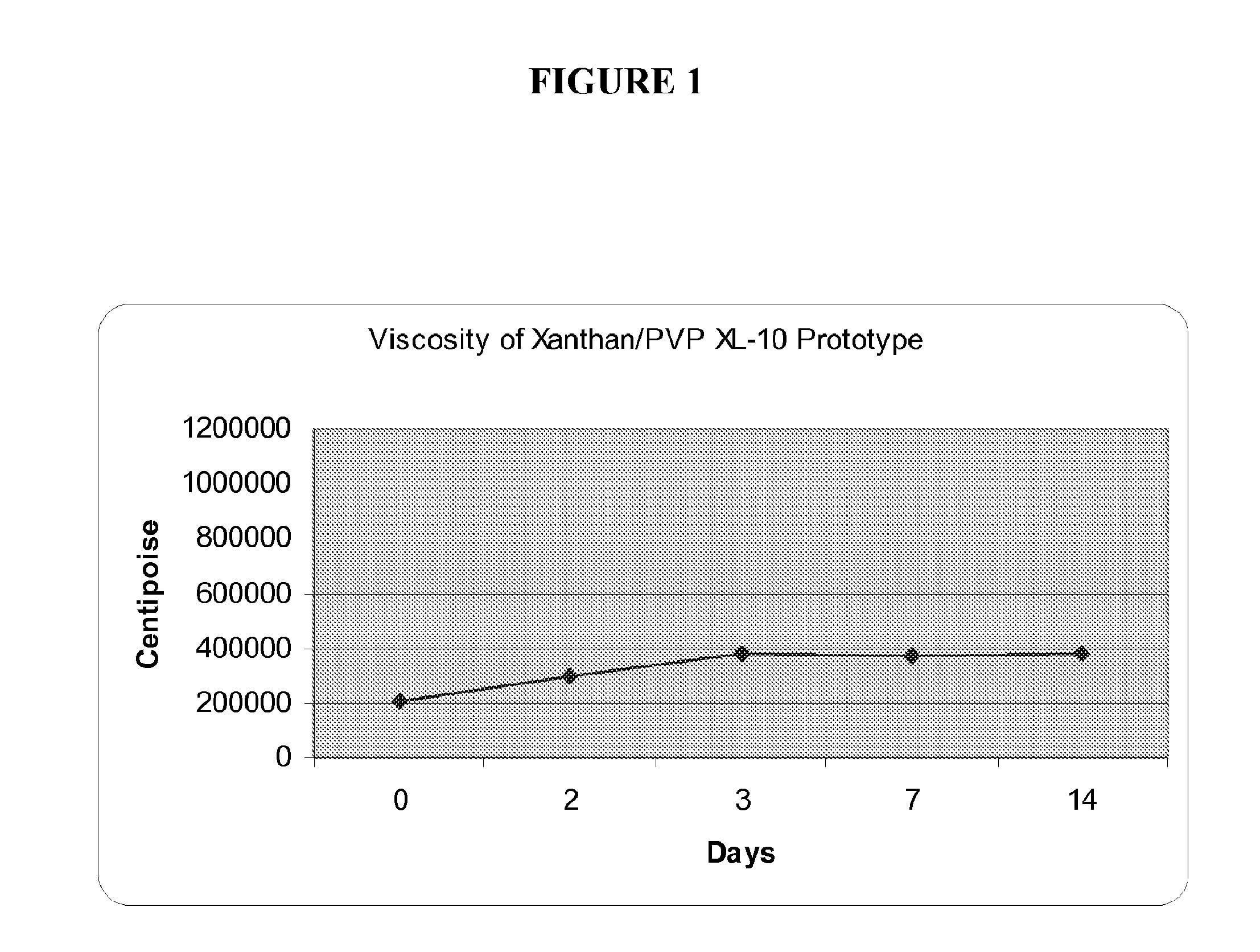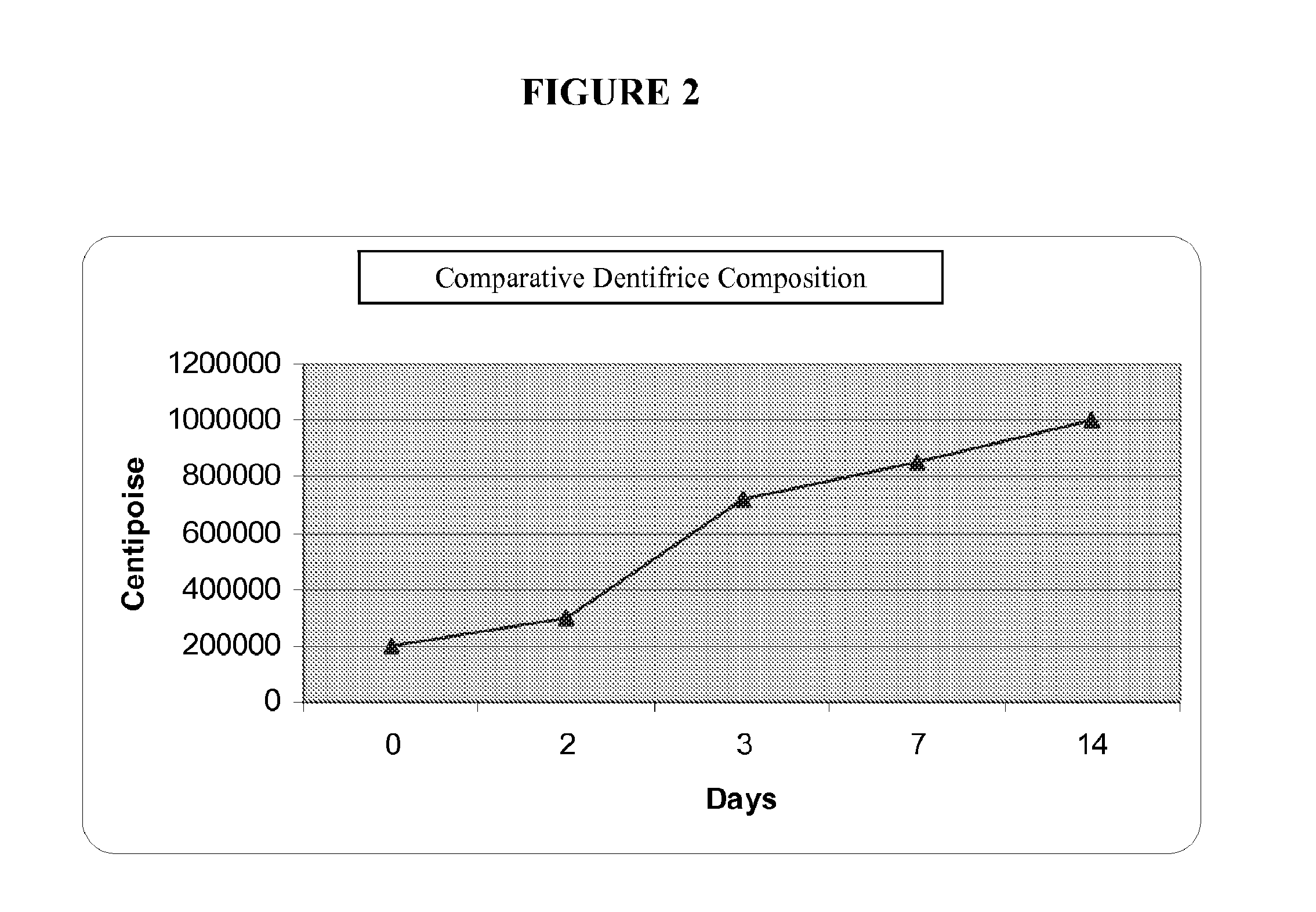Low water stannous fluoride plus zinc citrate dentifrice with improved stability, rheology, and efficacy
a technology zinc citrate, which is applied in the field of low water stannous fluoride plus zinc citrate dentifrice with improved stability, rheology, and efficacy, can solve the problems of difficult to provide these actives together in a single phase stable, unstable polyphosphates in high aqueous systems, and polyphosphates in an aqueous system are susceptible to hydrolysis, etc., to achieve stable viscosity and stability
- Summary
- Abstract
- Description
- Claims
- Application Information
AI Technical Summary
Benefits of technology
Problems solved by technology
Method used
Image
Examples
example 1
[0098]Dentifrice compositions were prepared having the formulations as indicated in Table 1.
TABLE 1INGREDIENTFormula AFormula BFormula CFormula DDeionized water6.0006.0004.0004.000Citric acid0.6000.1600.0000.000Trisodium citrate3.0000.8100.0000.000Zinc citrate2.0002.0002.0002.000Glycerin7.70020.0007.70014.000Stannous fluoride0.4540.4540.4540.454Propylene glycol7.0000.0007.0007.000Polyethylene glycol 6005.0007.0005.0009.000Tetrasodium2.0002.0002.0002.000pyrophosphateGlycerin28.84629.78632.44630.846Sodium tripolyphosphate3.0003.0003.0003.000Sodium CMC 7MF0.7000.0000.7000.700Sodium CMC 2000S1.0000.0001.0000.300Xanthan gum NF0.0000.2500.0000.000Polyplasdone XL-100.0001.0000.0000.000Poloxamer 4071.0000.0001.0000.000FD&C blue #10.0000.1900.0000.000Sodium saccharin0.5000.5000.5000.500Titanium dioxide0.5000.1500.5000.500Zeodent 11512.00012.00012.00010.000Zeodent 1654.0000.0006.0003.000Zeodent 10512.00012.00012.00010.000STP dental cream flavor1.2001.2001.2001.200Sodium lauryl sulfate1.5001.5...
example 2
[0101]The dentifrice compositions in accordance with Formula A and Formula C were subjected to an accelerated aging study to determine the stability of the stannous salt. The dentifrice compositions were subjected to a temperature of 105° F. for a period of 4 weeks. The initial and final amounts of soluble tin, representing the available stannous ion, were measured at the beginning and at the end of the test. The results are shown in Table 2.
TABLE 2Formula AFormula CInitial soluble tin (wt %)0.330.24Final soluble tin (wt %) after 4 weeks at 105° F.0.310.16
[0102]Table 2 shows that for the composition of Formula A the initial amount of soluble tin was 0.33 wt % which was reduced to 0.31 wt % at the end of the test, this being a small reduction (about 7%) in stannous tin availability which is acceptable in a commercial dentifrice.
[0103]Table 2 also shows that for the composition of Formula C the initial amount of soluble tin was 0.24 wt % which was reduced to 0.16 wt % at the end of th...
example 3
[0105]The aging study discussed above also investigated the stability of other actives in the composition of Formulas A and C, and the results are shown in Table 3.
TABLE 3Solu-bleIonicNa tripolyNa pyroNa orthoSolublezincFluoridePhosphatePhosphatePhosphatetin(wt(ppm)(wt %)(wt %)(wt %)(wt %)%)Formula AInitial9852.592.340.140.360.39After 49382.442.10.330.330.39weeks at105° F.After 810382.492.160.390.330.39weeks at105° F.After 129502.262.110.450.350.34weeks at105° F.Formula CInitial10292.862.07none0.240.46After 410082.821.800.190.160.42weeks at105° F.After 810852.992.240.310.150.40weeks at105° F.After 129282.752.130.220.140.45weeks at105° F.
[0106]Although the soluble tin reduced significantly after 4 weeks for Formula C, as discussed above, the soluble tin content did not significantly reduce further up to 12 weeks. The amounts of ionic fluoride, sodium tripolyphosphate, sodium pyrophosphate (which progressively converts into sodium orthophosphate) and soluble zinc remained at acceptabl...
PUM
| Property | Measurement | Unit |
|---|---|---|
| wt % | aaaaa | aaaaa |
| wt % | aaaaa | aaaaa |
| wt % | aaaaa | aaaaa |
Abstract
Description
Claims
Application Information
 Login to View More
Login to View More - R&D
- Intellectual Property
- Life Sciences
- Materials
- Tech Scout
- Unparalleled Data Quality
- Higher Quality Content
- 60% Fewer Hallucinations
Browse by: Latest US Patents, China's latest patents, Technical Efficacy Thesaurus, Application Domain, Technology Topic, Popular Technical Reports.
© 2025 PatSnap. All rights reserved.Legal|Privacy policy|Modern Slavery Act Transparency Statement|Sitemap|About US| Contact US: help@patsnap.com


